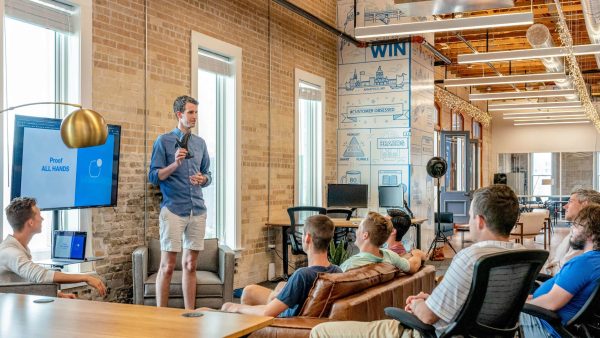An organization prioritizing employee development needs a continuous learning culture to drive employee learning and growth. Investing in a corporate LMS can support an organization’s learning and development efforts. Seven key benefits of a corporate LMS include:
1. Resource Management
2. Continuous Learning
3. Accommodates Different Learning Techniques4. Encourages Social and Collaborative Learning
5. On-Demand Learning
6. Increase Retention
7. Learning Data Management
1. Resource Management
The features and functionalities of a corporate LMS can save an organization manpower, time, and money. However, the biggest cost reduction occurs in training. Among other budget strategies, SHRM found that:
- 29% of companies budget $501-$1000 for learning and development
- 9% of companies budget $500 per employee
Some traditional methods for training include instructor-led training, simulation, and coaching. These methods can have a high cost, and may not be easily implemented for all departments. Organizations currently investing in training can save up to 40% if they switch to virtual learning. The right LMS can give a good ROI to organizations.
2. Continuous Learning Culture
Employees value consistent access and opportunities for career development by upskilling with current and relevant educational material.
According to a recent SHRM study:
- 57% of employees enjoy learning new things and developing skills
- 57% of employees pursue training outside of work, some because training is insufficient
- 54% want to enhance their opportunities for career development
Organizations looking to support employees’ goals for learning and development need to invest and promote a continuous learning culture within the company.
A corporate LMS can do this by being a platform to deliver the organization’s learning content. A flexible pricing structure with no hidden costs make a corporate LMS a more cost effective option for providing development opportunities to employees.
LMS features such as custom course surveys and assessment tests can help organizations measure the effectiveness of their learning content.To learn more about choosing the right corporate LMS for your organization, read our 2022 Buyer’s Guide.
3. Accommodates Different Learning Techniques
Part of supporting employee development is providing employees with opportunities for more personalized learning, self directed learning, and Just In Time (JIT) learning.
- Personalized learning: Customizing learning to an employee’s strengths, needs, skills, and interests
- Self directed learning: When a learner takes charge of planning, continuing, and evaluating their learning experiences
- JIT: When the right educational material is readily available to the learners when it is needed
Depending on its features and functionalities, a corporate LMS can provide opportunities for all of these learning techniques.
A learning system with Learning Paths (also known as Roadmaps) supports personalized learning by enabling admins to string together courses and programs to grow employees’ skills.
By offering learners access to other courses, a corporate LMS can give learners more control over their development. Qbic enables admins to designate courses as optional for learners who wish to opt into more learning material.
An LMS equipped with mobile access and paired with Roadmaps designed using microlearning for the most commonly accessed topics can provide a very gratifying JIT learning experience.
4. Encourages Social and Collaborative Learning
The core of Social and Collaborative Learning in the workplace is for employees to work together improving the learning experience, employee engagement, and knowledge retention. Improved engagement paired with support for a continuous learning environment can result in an increase in productivity.
A corporate LMS with a Discussion Forum and features for Gamification supports efforts for social and collaborative learning. Discussion Forums create opportunities for collaboration by being a space to ask questions, and to learn from others. Features for gamification such as points, badges, and leaderboards combine the organization’s goals with awards and recognition. Read our introduction to Gamification to learn more.
5. On-Demand Learning
A corporate LMS with mobile capability makes learning material accessible from anywhere at any time. Easy accessibility to learning material is critical for continuous learning and inclusive employee development within an organization.
It also gives learners more control over their learning, further supporting goals such as improving learner engagement. To learn more about corporate LMS with mobile capability refer to our 2022 Buyer’s Guide.
6. Increase Retention
The cost of acquiring new employees is high and excessive turnover rates can impact an organization’s ability to grow in a sustainable manner.
One method for increasing employee retention is to prioritize employee development and training within an organization. Development is highly valued by employees, with 76% of employees saying they are more likely to stay at an organization that offers continuous training.
Organizations that invest in training and development report sales growth, increased productivity, work quality and higher employee morale. The right corporate LMS with features that support learner engagement, inclusivity and collaboration facilitates an organization’s goals for training and development.
7. Learning Data Management
An organization can only get the benefits of prioritizing a continuous learning culture if the educational material they provide to their employees is effective and relevant. A corporate LMS can achieve this with learning data management in the system’s reporting and analytics. Some reports to measure effectiveness include:
- Completed courses and roadmaps VS pending and overdue courses
- Time spent on training
- Number of test attempts


